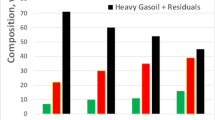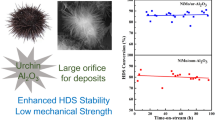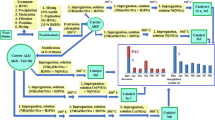Abstract
Catalytic hydrodesulfurization plays an important role in the conversion of sulfur laden residual oils. Cobalt molybdate catalysts are more commonly used for this process. In the present study, a precipitation technique at constant pH value was used to prepare alumina support. This material has very narrow pore size distribution centered around the pore diameter of about 8 nm. It also has a large surface area and pore volume and, therefore, can be used as a support for CoMo RDS catalysts. The results of temperature-programmed desorption of ammonia indicated that this catalyst has higher surface acidity than the conventional catalysts. The high surface acidity could enhance the cracking ability of the catalyst. The RDS reaction results showed that the samples prepared by precipitation are more active and more stable than the conventional catalysts, at least in the first 72 h. The results can be attributed to its unique pore structure and high surface acidity.
Abstract
Каталитическое гидродесульфурирование играет важную роль в превращениях серосодержащих остаточных нефтей. Обычно для этого процесса используют кобальтмолибдатные катализаторы. Для приготовления алюмоземного носителя использовали технику высаждения при постоянном pH. Такой материал обладает весьма узким распределением пор по размерам со средним диаметром пор около 8 нм. Он также обладает большой поверхностной площадью и объемом пор и поэтому может служить носителем катализаторов CoMo ВДС. Результаты ТПД аммиака свидетельствуют о том, что этот катализатор обладает повышенной поверхностной кислотностью по сравнению с обычными катализаторами, которая повышает способность к крекингу катализатора. Результаты ВДС свидетельствуют о том, что образцы, приготовленные высаждением, более активны и стабильны, чем обычные катализаторы, по-крайней мере в первые 72 часа. Эти результаты приписывают уникальной структуре пор и высокой поверхностной кислотности.
Similar content being viewed by others
References
H. Topsoe, B. S. Clause, N. Y. Topsoe, E. Pedersen: Ind. Eng. Chem. Funds.,25, 25 (1986).
B. G. Johnson, F. E. Massoth, J. Bartholdy: AIChE J.,32, 1980 (1986)
W. C. Hsu “RDS Reaction over CoMo/AAP Catalysts”, M. S. Thesis, National Central Univ., Taiwan, 1989.
E. Ruckenstein, M. C. Tsai: AIChE J.,32, 697 (1981)
Author information
Authors and Affiliations
Rights and permissions
About this article
Cite this article
Chen, Y.W., Tsai, M.C., Kang, B.C. et al. A new catalyst for hydrodesulfurization of heavy residue. React Kinet Catal Lett 43, 439–446 (1991). https://doi.org/10.1007/BF02064710
Received:
Accepted:
Issue Date:
DOI: https://doi.org/10.1007/BF02064710




